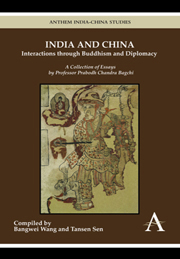 India and China: Interactions through Buddhism and Diplomacy
India and China: Interactions through Buddhism and Diplomacy Book contents
- Frontmatter
- Contents
- Compilers' Note
- Introduction (English and Chinese)
- Part One
- 1 Ancient Chinese Names of India
- 2 The Beginnings of Buddhism in China
- 3 Indian Influence on Chinese Thought
- 4 A Note on the Avadānaśataka and its Chinese Translation
- 5 Bodhisattva-śīla of Śubhākarasiṁha
- 6 A Fragment of the Kāśyapa Saṁhitā in Chinese
- 7 The Chinese Mysticism
- 8 Some Early Buddhist Missionaries of Persia in China
- 9 Some Letters of Hiuan-Tsang and his Indian Friends
- 10 New Lights on the Chinese Inscriptions of Bodhgayā
- 11 A Buddhist Monk of Nālandā amongst the Western Turks
- 12 Political Relations between Bengal and China in the Pathan Period
- 13 Chinese Coins from Tanjore
- 14 Report on a New Hoard of Chinese Coins
- 15 Ki-pin and Kashmir
- 16 Sino-Indian Relations – The Period of the United Empires (618–1100 A.D.)
- Part Two Short Articles
- Part Three Articles in Bengali
- Appendix
- Index
2 - The Beginnings of Buddhism in China
from Part One
Published online by Cambridge University Press: 05 March 2012
- Frontmatter
- Contents
- Compilers' Note
- Introduction (English and Chinese)
- Part One
- 1 Ancient Chinese Names of India
- 2 The Beginnings of Buddhism in China
- 3 Indian Influence on Chinese Thought
- 4 A Note on the Avadānaśataka and its Chinese Translation
- 5 Bodhisattva-śīla of Śubhākarasiṁha
- 6 A Fragment of the Kāśyapa Saṁhitā in Chinese
- 7 The Chinese Mysticism
- 8 Some Early Buddhist Missionaries of Persia in China
- 9 Some Letters of Hiuan-Tsang and his Indian Friends
- 10 New Lights on the Chinese Inscriptions of Bodhgayā
- 11 A Buddhist Monk of Nālandā amongst the Western Turks
- 12 Political Relations between Bengal and China in the Pathan Period
- 13 Chinese Coins from Tanjore
- 14 Report on a New Hoard of Chinese Coins
- 15 Ki-pin and Kashmir
- 16 Sino-Indian Relations – The Period of the United Empires (618–1100 A.D.)
- Part Two Short Articles
- Part Three Articles in Bengali
- Appendix
- Index
Summary
Although during the first few centuries of Buddhist missionary activities in China the lead was generally given by the Buddhist scholars of Iran and of countries in Central Asia, Indian Buddhist scholars did not fail to make their presence felt in the various centres of Buddhism in China and create amongst the Chinese an interest in Buddhism and Indian culture in general which would not have been otherwise possible. The first two Indian scholars who came to China in 68 A.D. during the reign of Ming ti, Kāśyapa Mātanga and Dharmarakṣa, translated five Buddhist texts into Chinese. These were resumés of the legends of the birth and childhood of Buddha, a resumé of his predication, a short treatise on the main principles of Buddhism, a sūtra on the purity of monastic life and a sūtra on the principles of ascetic life for those who wanted to follow the way of spiritual perfection. Four of these works were judicious selection. The “Sūtra of 42 sections” which has been preserved up till now is clearly a catechism for the use of missionaries intending to preach the Buddhist religion in foreign countries. The original text did not belong to the Buddhist Canon. It had been compiled in order to give a general idea of the religion and its practices. The first Buddhist monastery in China Po ma sse, the “White Horse Monastery” was built at Lo-yang for these two Indian missionaries.
- Type
- Chapter
- Information
- India and China: Interactions through Buddhism and DiplomacyA Collection of Essays by Professor Prabodh Chandra Bagchi, pp. 13 - 24Publisher: Anthem PressPrint publication year: 2011
